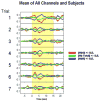Noninvasive diffusive optical imaging of the auditory response to birdsong in the zebra finch
- PMID: 23322445
- PMCID: PMC4371729
- DOI: 10.1007/s00359-012-0788-0
Noninvasive diffusive optical imaging of the auditory response to birdsong in the zebra finch
Abstract
Songbirds communicate by learned vocalizations with concomitant changes in neurophysiological and genomic activities in discrete parts of the brain. Here, we tested a novel implementation of diffusive optical imaging (also known as diffuse optical imaging, DOI) for monitoring brain physiology associated with vocal signal perception. DOI noninvasively measures brain activity using red and near-infrared light delivered through optic fibers (optodes) resting on the scalp. DOI does not harm subjects, so it raises the possibility of repeatedly measuring brain activity and the effects of accumulated experience in the same subject over an entire life span, all while leaving tissue intact for further study. We developed a custom-made apparatus for interfacing optodes to the zebra finch (Taeniopygia guttata) head using 3D modeling software and rapid prototyping technology, and applied it to record responses to presentations of birdsong in isoflurane-anesthetized zebra finches. We discovered a subtle but significant difference between the hemoglobin spectra of zebra finches and mammals which has a major impact in how hemodynamic responses are interpreted in the zebra finch. Our measured responses to birdsong playback were robust, highly repeatable, and readily observed in single trials. Responses were complex in shape and closely paralleled responses described in mammals. They were localized to the caudal medial portion of the brain, consistent with response localization from prior gene expression, electrophysiological, and functional magnetic resonance imaging studies. These results define an approach for collecting neurophysiological data from songbirds that should be applicable to diverse species and adaptable for studies in awake behaving animals.
Figures






Similar articles
-
Functional MRI of the zebra finch brain during song stimulation suggests a lateralized response topography.Proc Natl Acad Sci U S A. 2007 Jun 19;104(25):10667-72. doi: 10.1073/pnas.0611515104. Epub 2007 Jun 11. Proc Natl Acad Sci U S A. 2007. PMID: 17563380 Free PMC article.
-
Neural representation of spectral and temporal features of song in the auditory forebrain of zebra finches as revealed by functional MRI.Eur J Neurosci. 2007 Nov;26(9):2613-26. doi: 10.1111/j.1460-9568.2007.05865.x. Epub 2007 Oct 23. Eur J Neurosci. 2007. PMID: 17970728 Free PMC article.
-
The neural response of female zebra finches (Taeniopygia guttata) to conspecific, heterospecific, and isolate song depends on early-life song exposure.Behav Processes. 2019 Jun;163:37-44. doi: 10.1016/j.beproc.2017.12.022. Epub 2017 Dec 21. Behav Processes. 2019. PMID: 29274763
-
Neural coding of sound envelope structure in songbirds.J Comp Physiol A Neuroethol Sens Neural Behav Physiol. 2018 Mar;204(3):285-294. doi: 10.1007/s00359-017-1238-9. Epub 2017 Dec 12. J Comp Physiol A Neuroethol Sens Neural Behav Physiol. 2018. PMID: 29234861
-
Sound sequences in birdsong: how much do birds really care?Philos Trans R Soc Lond B Biol Sci. 2020 Jan 6;375(1789):20190044. doi: 10.1098/rstb.2019.0044. Epub 2019 Nov 18. Philos Trans R Soc Lond B Biol Sci. 2020. PMID: 31735149 Free PMC article. Review.
Cited by
-
From brain to blood vessels and back: a noninvasive optical imaging approach.Neurophotonics. 2017 Jul;4(3):031208. doi: 10.1117/1.NPh.4.3.031208. Epub 2017 Apr 7. Neurophotonics. 2017. PMID: 28413807 Free PMC article. Review.
References
-
- Beauvoit B, Evans SM, Jenkins TW, Miller EE, Chance B. Correlation between the light scattering and the mitochondrial content of normal tissues and transplantable rodent tumors. Anal Biochem. 1995;226:167–174. - PubMed
-
- Berwick J, Martin C, Martindale J, Jones M, Johnston D, Zheng Y, Redgrave P, Mayhew J. Hemodynamic response in the unanesthetized rat: intrinsic optical imaging and spectroscopy of the barrel cortex. J Cereb Blood Flow Metab. 2002;22:670–679. - PubMed
-
- Boumans T, Gobes SM, Poirier C, Theunissen FE, Vandersmissen L, Pintjens W, Verhoye M, Bolhuis JJ, Van der Linden A. Functional MRI of auditory responses in the zebra finch forebrain reveals a hierarchical organisation based on signal strength but not selectivity. PLoS One. 2008;3:e3184. - PMC - PubMed
-
- Boumans T, Vignal C, Smolders A, Sijbers J, Verhoye M, Van Audekerke J, Mathevon N, Van der Linden A. Functional magnetic resonance imaging in zebra finch discerns the neural substrate involved in segregation of conspecific song from background noise. J Neurophysiol. 2008;99:931–938. - PubMed
Publication types
MeSH terms
Substances
Grants and funding
LinkOut - more resources
Full Text Sources
Other Literature Sources

